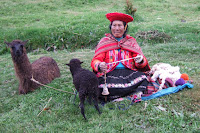Travel Dates 31st-8th April 2010.
Please click on any picture to see the larger version.
I enjoyed five days in Cusco before going to Machu Picchu and another day after. I found it the most interesting city in Peru.
After staying just one night at the Walk On Inn, which should be re-named the Climb on Up (the picture shows part of the long uphill street from the Inn to the main square), I negotiated a good price at the Royal Inka 1 hotel and stayed there for the rest of my time in Cusco. The room and service were excellent in a perfect location – but be sure not to get a road-side room. Mine was in the interior and very quiet. The shoe-cleaners were in the pleasant Plaza Regocuo in front of the hotel.
The population is about 360,000 with a high proportion of Quechuan ancestry but the style and layout is still Spanish, with the major churches and civil offices surrounding the main square.

Cusco pre-dates the Spanish by several centuries and was the Inca's capital when they arrived. At that time it was the hub of an empire mainly west of the Andes stretching thousands of km from the southern regions of present Colombia to the northern regions of Chile. The town is a UNESCO World heritage site and sees about a million tourists a year - when Machu Picchu is open.
Something that the guides did not mention and that I have not found on the net was the system of communications and control employed by the Inca to manage such a far-flung empire. When you look at the ruggedness of the terrain it had to be a sophisticated and effective system. It was linked by a complex system of trails. Remember that they had neither horses nor wheeled vehicles. Consider the time it must have taken to communicate. Even now it takes hikers four days of walking to do the short 40km Inca trail from Ollantaytambo to Machu Picchu.
Possibly disruption of that system was a significant factor in the ease with which a handful of Spanish conquistadores conquered the Inca.
The Spanish changed everything, using force, religion and town-building to impose their culture over the Quechuan people. In many areas they deliberately destroyed the Inca's cities, towns and sacred sites or used them as quarries for their own construction. Sometimes they deliberately built on the Quechuan foundations, as you can see in the picture at the top of this page. These next few pictures show the difference between the wonderful mortar-less fine masonry of the Inca's craftsmen and the Spanish mortared construction that was added to it inside that building.
There were simply too many sites, or sometimes they were too massive, for the Spanish to destroy them all. For example one of the most sacred sites, Saqsayhuman, overlooks the city. Note again the quality of the construction and the massive stones used. The zig-zag shape of the wall is representative of the lightning, the harbinger of rain; it may also relate to the sacred serpent. However, you might note the giant statue of the Virgin Mary off to the left of the picture. The terrain is such that the Virgin (now flood-lit at night) can be seen from the town square but the Incan ruins are not visible from there. The other pictures show some of the other Incan sites surrounding Cusco.


While mentioning religion, I deliberately planned my visit to Cusco to coincide with Easter to see the displays and processions. I was fortunate enough to be in Granada, Spain, for Easter in 2003 and was looking forward to a similar experience. Unfortunately it turned out to be a shadow of the Granada processions. Only a half-dozen images were carried around the centre of town and only a couple were lit. It was interesting, but a bit disappointing.


On Easter Sunday the Quechuan people had a festival of street performers outside the convent near the market. The various entertainers were each surrounded by a circle of applauding watchers. The most popular acts appeared to be comedians and martial arts demonstrations.

I spent much of my time in Cusco, as I do in most cities, just wandering quietly around the back streets, seeing the local people away from the tourist traps and eating breakfast and lunch in the same restaurants they ate in. My conversations in mutually incomprehensible languages weren't very informative but were still lots of fun.
I enjoyed Cusco's people; they were friendly and happy. At no stage in my wanders did I ever feel threatened or uncomfortable about security.

Cheers, Alan













"Remember that they had neither horses nor wheeled vehicles. Consider the time it must have taken to communicate. Even now it takes hikers four days of walking to do the short 40km Inca trail from Ollantaytambo to Machu Picchu."
ReplyDeleteBut they had chasquis - trained relay runners who were their version of the Old West's Pony Express. They could cover the 1000+ miles (1600+ km) from Cusco to Quito, Ecuador in about a week.
Chasqui
http://en.wikipedia.org/wiki/Chasqui
And they kept track of things using quipus, which were knotted strings. It helped that their society was built on a decimal system pyramid - so a leader A had ten B leaders under him, who each had ten C leaders under them, etc. (this last part I remember from history lessons long ago).
Quipu
http://en.wikipedia.org/wiki/Quipu
Glad you got to see and enjoy that part of the world!
Terry
Thanks for the information Terry. Always something new to learn.
ReplyDeleteI'd love to go back; I think I enjoyed the Peruvians as a people most on my trip. But, so much to see, so little time. Maybe someday.
Cheers, Alan.